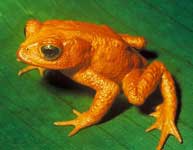The golden toad (Bufo periglenes) was a small, shiny, bright true toad that was once abundant in a small region of high-altitude cloud-covered tropical forests, about 30 square kilometers in area, above the city of Monteverde, Costa Rica. For this reason, it is sometimes also called the Monteverde golden toad, or the Monte Verde toad. Other common English names include Alajuela toad and orange toad. They were first described in 1966 by the herpetologist Jay Savage.[1] Since 1989, not a single B. periglenes is reported to have been seen anywhere in the world, and it is classified by the IUCN as an extinct species.[2] Its sudden extinction is cited as part of the decline in amphibian populations, which may be attributable to climate change brought on by global warming[3], a fungal epidemic specific to amphibians or other factors, combined or acting independently. Description The golden toad was one of more than 250 species in the family Bufonidae--the "true toads". B. periglenes inhabited northern Costa Rica’s Monteverde Cloud Forest Preserve, distributed over an area of roughly 10 square kilometres (3.9 sq mi) at an average elevation of 1.5 kilometres (0.93 mi).[4] Morphology Adult males measured just barely 5 centimetres (2.0 in) long. Males have been described as being "Day-Glo golden orange",[5] and unlike most toads their skin was shiny and bright. Jay Savage was so surprised upon first seeing them that he did not believe they could be real; he is quoted as saying: "I must confess that my initial response when I saw them was one of disbelief and suspicion that someone had dipped the examples in enamel paint."[6] Exhibiting sexual dimorphism, female toads were slightly larger than the males, and looked very different. Instead of being bright orange, females were colored dark olive to black with scarlet spots encircled by yellow. Reproduction Very little is known about the behavior of B. periglenes;[3] however, it is believed that they lived underground,[3] as they were not seen for most of the year. In contrast, their presence in the Cloud Forest Preserve was obvious during their mating season, which lasted only a few weeks. For a few weeks in April, after the dry season ended and the forest became wetter, males would gather in large numbers near ground puddles and wait for the females. The males would fight with each other for opportunities to mate until the end of their short mating season, after which the toads retreated to their burrows.[3] Eggs were laid in seasonal water catchments in clutches, the average size of which was 228 eggs.[7] After two months, they hatched into tadpoles.[7] In 1987, an American ecologist and herpetologist, Martha Crump, was fortunate enough to see the toad's mating rituals. In her book, In Search of the Golden Frog [sic], she described it as "one of the most incredible sights I've ever seen," and said they looked like "statues, dazzling jewels on the forest floor."[5] On April 15, 1987, Crump recorded in her field diary that she counted 133 toads mating in one "kitchen sink-sized pool"[5] that she was observing. Five days later, she witnessed the pools in the area drying, which she attributed to the effects of El Niño-Southern Oscillation, "leaving behind desiccated eggs already covered in mold."[5] The toads attempted to mate again that May. Of the 43,500 eggs that Crump found, only twenty-nine tadpoles survived the drying of the forest's ground.[5] Conservation history Jay Savage first discovered the toads in 1966.[1] From their discovery in 1966 for about 17 years, and from April to July in 1987, over 1500 adult toads were seen.[4] Only ten[2] or eleven toads were seen in 1988,[4] including one seen by Crump, and none have been seen since May 15, 1989, when Crump last saw the same solitary male toad that she had seen the year before.[3] In the period between discovery and disappearance, the golden toad was commonly featured on posters promoting the biodiversity of Costa Rica.[8] There is a single anecdotal report from the 1970s of a golden toad in the mountains of Guatemala near the village of Chichicastenango, but this sighting has not been confirmed. There is also another extinct frog sometimes compared to the golden toad found in the same forest in Costa Rica, named Holdridge's Toad. Extinction As late as 1994, five years after the last sighting, researchers still hoped that B. periglenes continued to live in underground burrows, as similar toad species have lifespans of up to twelve years.[4] By 2004 IUCN listed the species as extinct, after an evaluation involving Savage (who had first discovered them 38 years earlier). IUCN's extinction was based on the lack of sightings since 1989 and the "extensive search[ing]" that had been done since without result.[2] Tim Flannery describes the extinction of the golden toad as Costa Rica's first extinction due to global warming,[3] but this is not the only explanation for the loss of the species that has been put forward. Jennifer Neville examines the different hypotheses explaining the extinction of the golden toad in her article "The Case of the Golden Toad: Weather Patterns Lead to Decline". Neville comes to the conclusion that Crump's El Niño hypothesis is "clearly support[ed]" by the available data.[4] IUCN gives numerous possible reasons in its description of the past threats to the species, including "[the golden toad's] restricted range, global warming, chytridiomycosis and airborne pollution".[2] Neville also mentions arguments that an increase in UV-B radiation, fungus or parasites, or lowered pH levels contributed to the Golden Toad's extirpation.[4] Notes and references
External links
Retrieved from "http://en.wikipedia.org/" |
|

